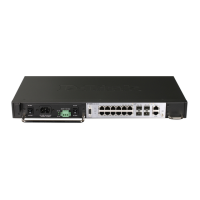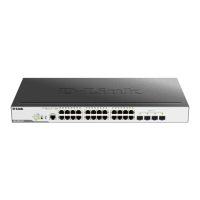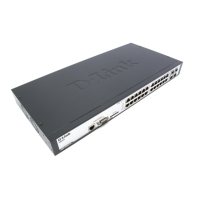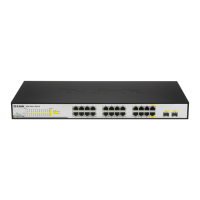DGS-3700-12/DGS-3700-12G Series Layer 2 Gigabit Ethernet User Manual
183
profile.
Select Ethernet to instruct the Switch to examine the layer 2 part of each packet header.
Select IPv4 to instruct the Switch to examine the IPv4 address in each frame's header.
Select IPv6 to instruct the Switch to examine the IPv6 address in each frame's header.
Select Packet Content Mask to specify a mask to check the content of the packet header.
802.1Q VLAN
Selecting this option instructs the Switch to examine the VLAN part of each packet header
and use this as the, or part of the criterion for forwarding.
IPv4 DSCP
Selecting this option instructs the Switch to examine the DiffServ Code part of each packet
header and use this as the, or part of the criterion for forwarding.
Source IP Mask
Enter an IP address mask for the source IP address.
Destination IP Mask
Enter an IP address mask for the destination IP address.
Protocol
Selecting this option instructs the Switch to examine the protocol type value in each frame's
header. You must then specify what protocol(s) to include according to the following
guidelines:
Select ICMP to instruct the Switch to examine the Internet Control Message Protocol (ICMP)
field in each frame's header.
Select Type to further specify that the access profile will apply an ICMP type value, or
specify Code to further specify that the access profile will apply an ICMP code
value.
Select IGMP to instruct the Switch to examine the Internet Group Management Protocol
(IGMP) field in each frame's header.
Select Type to further specify that the access profile will apply an IGMP type value.
Select TCP to use the TCP port number contained in an incoming packet as the forwarding
criterion. Selecting TCP requires a source port mask and/or a destination port mask is to be
specified. The user may also identify which flag bits to filter. Flag bits are parts of a packet
that determine what to do with the packet. The user may filter packets by filtering certain flag
bits within the packets, by checking the boxes corresponding to the flag bits of the TCP field.
The user may choose between urg (urgent), ack (acknowledgement), psh (push), rst (reset),
syn (synchronize), fin (finish).
src port mask – Specify a TCP port mask for the source port in hex form (hex 0x0-0xffff),
which you wish to filter.
dst port mask – Specify a TCP port mask for the destination port in hex form (hex 0x0-
0xffff) which you wish to filter.
Select UDP to use the UDP port number contained in an incoming packet as the forwarding
criterion. Selecting UDP requires that you specify a source port mask and/or a destination
port mask.
src port mask – Specify a UDP port mask for the source port in hex form (hex 0x0-0xffff).
dst port mask – Specify a UDP port mask for the destination port in hex form (hex 0x0-
0xffff).
Protocol_id <0x0-0xff> – Enter a value defining the protocol ID in the packet header to mask.
user_define_mask <hex 0x0-0xffffffff> – Enter a value defining the mask options behind the
IP header.
Click Create to set this entry in the Switch’s memory.
To view the settings of a previously correctly created profile, click the corresponding Show Details button on the CPU
Access Profile List window. The following window opens:

